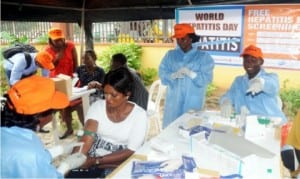Health
Age Determines Fertility Rate Of Woman — Expert

Members of Public Health Nursing, University College Hospital at public screening marking the World Hepatitis Day in Ibadan, yesterday
The Chairman NISA Pre
mier Hospital Jabi, Dr Ibrahim Wada in Abuja, has attributed age to a major determinant of the fertility rate of a woman.
Wada said this at a workshop in Abuja with the theme: “Fertility Preservation In 21st Century.“
He said that the objective of the workshop was to enlighten couples with fertility challenges on how to preserve their eggs and sperm upon late marriage to avoid childlessness.
Wada explained that the brunt of fertility challenges was more on the female folk, adding that a woman had a specified number of eggs in her which could not be replenished when any got lost.
“The testis of a man produces approximately 200 to 500 million sperm on a daily basis, especially when the man is at his prime of about 28 years.
“But the woman has about 400,000 eggs which she is born with and that is all she could ever have and no new ones are going to be made.
“The quality of the egg from a woman depreciates as she ages which could lead to abnormal and irregular reproductive system,” he said.
Wada revealed that when a woman spent her eggs, at a time she would run out of eggs from her ovary resulting in seizure of her menstruation and eventual menopause, stating, however, that abnormal ovulation; blockage of fallopian tubes, infection and social habits such as smoking, drinking alcohol could hamper the fertility rate of a woman.
Wada said that when a woman married at late age, the absence of pregnancy could due to cancerous growth and fibroid.
He also said that infertility in men could be caused by testicular cancer and trauma due to accident among other issues.
He said that couples could avoid infertility by marrying early when possible, live healthy life and as well preserve their eggs/sperm to ensure that their reproductive life was not infected.
Wada stated that the hospital was collaborating with London Women’s Clinic to develop a new initiative called: “Fertility Preservation“ to help reduce infertility in couples.
According to him, the initiative involves collecting and freezing eggs/sperm which will be done at NISA Premier Hospital, Abuja with sophisticated equipment and subsidised rate.
Also speaking Consultant Gynecologist, London Women’s Clinic, Dr Julian Mamiso, said that couples, after trying for one year without conception, should seek help from medical experts.
Mamiso added that preservation of eggs and sperm, to be carried out in the initiative, was for individuals who were advanced in age.
He warned that having children normally and hitch-free could be very challenging for women of 40 and above.
“Production of egg and sperm in humans is like a pyramid, as you grow older, the egg production is lower and low in quality as well.
“The success rate of getting frozen eggs is about 90 per cent, out of 10 eggs frozen; you can get nine that survived.
“If you put the eggs back to the uterus, the percentage of getting an embryo from those eggs to produce a baby is high,” he said.
Mamiso added that the process of collecting eggs/sperm from individuals was a simple process, which would not cause further challenge on the individual, adding that it did not damage the embryo.
He, however, said that before eggs/sperm were collected for freezing, there was need for a legal backing for record references.
On his part, a laboratory technician, Mr Chris Danga, said that eggs and sperm samples collected from individuals would be preserved either by freezing slowly or rapidly.
Danga said that freezing eggs/sperm rapidly produced high rate results and higher number of eggs to be preserved.
He added that the eggs and sperm were to be collected from individuals and preserved in straws and vials with adequate labeling and identification with two or more officials having observed the specimen.
The officer also said that the life span of the eggs/sperm collected could live for over 30 years, depending on the agreement in the legal document.
Health
‘How Micro RNA Research Won Nobel Prize’
Two United States scientists who unraveled the human micro RNA have won the Nobel Prize in Physiology or Medicine 2024.
Victor Ambros and Gary Ruvkun won the coveted prize for their work on microRNA as their discoveries help explain how complex life emerged on earth and how the human body is made up of a wide variety of different tissues.
MicroRNAs influence how genes – the instructions for life – are controlled inside organisms, including humans.
Every cell in the human body contains the same raw genetic information, locked in our DNA.
However, despite starting with the identical genetic information, the cells of the human body are wildly different in form and function.
The electrical impulses of nerve cells are distinct from the rhythmic beating of heart cells. The metabolic powerhouse that is a liver cell is distinct to a kidney cell, which filters urea out of the blood.
The light-sensing abilities of cells in the retina are different in skillset to white blood cells that produce antibodies to fight infection.
So much variety can arise from the same starting material because of gene expression.
The US scientists were the first to discover microRNAs and how they exerted control on how genes are expressed differently in different tissues.
The medicine and physiology prize winners are selected by the Nobel Assembly of Sweden’s Karolinska Institute.
They said: “Their groundbreaking discovery revealed a completely new principle of gene regulation that turned out to be essential for multicellular organisms, including humans.
“It is now known that the human genome codes for over 1,000 microRNAs.”
Health
WHO Begins Regulation On Antibiotic Waste
The World Health Organisation (WHO) has begun acting to curb effects of antibiotic pollution.
The new guidance on wastewater and solid waste management for antibiotic manufacturing sheds light on this important but neglected challenge ahead of the United Nations General Assembly (UNGA) High-Level Meeting on antimicrobial resistance (AMR) taking place on 26 September 2024.
The emergence and spread of AMR caused by antibiotic pollution could undermine the effectiveness of antibiotics globally, including the medicines produced at the manufacturing sites responsible for the pollution.
Despite high antibiotic pollution levels being widely documented, the issue is largely unregulated and quality assurance criteria typically do not address environmental emissions. In addition, once distributed, there is a lack of information provided to consumers on how to dispose of antibiotics when they are not used, for example, when they expire or when a course is finished but there is still antibiotic left over.
“Pharmaceutical waste from antibiotic manufacturing can facilitate the emergence of new drug-resistant bacteria, which can spread globally and threaten our health. Controlling pollution from antibiotic production contributes to keeping these life-saving medicines effective for everyone,” said Dr Yukiko Nakatani, WHO Assistant Director-General for AMR ad interim.
Globally, there is a lack of accessible information on the environmental damage caused by manufacturing of medicines.
“The guidance provides an independent and impartial scientific basis for regulators, procurers, inspectors, and industry themselves to include robust antibiotic pollution control in their standards,” said Dr Maria Neira, Director, Department of Environment, Climate Change and Health, WHO. “Critically, the strong focus on transparency will equip buyers, investors and the general public to make decisions that account for manufacturers’ efforts to control antibiotic pollution.”
Health
Kebbi Harmonises Doctors’ Salaries To Curb Brain Drain
In a concerted effort to curb brain drain, the Kebbi State Government has harmonised medical doctors’ salaries to be at par with their colleagues in the federal government’s tertiary health facilities.
Kebbi State Commissioner for Health, Musa Inusa-Isma’il, disclosed this at the handing over of ambulances to the state-owned health facilities at the Ministry of Health in Birnin Kebbi yesterday.
Inusa Isma’il, according to a statement by Ahmed Idris, the Chief Press Secretary to the governor, said the essence of the harmonisation was to retain the existing medical doctors and attract more to the services of the state.
According to him, the doctors across the state had already started enjoying the new salaries from August 2024.
He said the release of the vehicles was in fulfilment of Governor Nasir Idris’ promise to uplift health care services in the state.
“His Excellency said I should inform you, the beneficiaries of this gesture, that the vehicle should be strictly used for the intended purpose. It should not be used for anything else.
“If there is no referral case, each of the vehicles must be parked at the hospital by 6 pm. The governor said you should warn your drivers against reckless driving as well as violating the instructions.
“We should also do everything possible to reciprocate the gesture by working according to the terms and conditions attached,” he advised.
The benefiting health facilities included Sir Yahaya Memorial Hospital, Birnin Kebbi; State Teaching Hospital, Kalgo; General Hospital, Argungu; General Hospital, Yauri; General Hospital, Zuru; and General Hospital, Bunza.
In his speech, the permanent secretary of the ministry, Dr Shehu Koko, recalled that the ambulances were handed over to the ministry last Friday by the governor for the onward handover to the benefiting hospitals.
He observed that the ambulances would go a long way in improving the referral system in the state, adding that delays in reaching the secondary and tertiary facilities would be eliminated.
The permanent secretary attributed the high rate of maternal mortality in the country to delays in getting to the health facilities for proper medical care.
“We believe with the provision of these ambulances, part of the gaps we have in our referral system will be addressed, whereby patients who require secondary healthcare could be easily transported to secondary and tertiary health centres, where they can get such help,” he said.
In a goodwill message, Commissioner for Information and Culture Alhaji Yakubu Ahmed expressed gratitude to the governor for the support he has given to the ministry to excel.
While advising the beneficiaries to use the vehicles judiciously, the commissioner advised that services and maintenance of the vehicles must be prompt to derive the maximum benefits from the vehicles.
The commissioner also highlighted some achievements recorded by the government in the last year, including beautification of the state capital, completion of a multimillion-naira ultramodern state secretariat, road construction, construction and renovation of classrooms and upgrading of some health facilities, among others.
-
Rivers4 days ago
Army Deactivates 16 Illegal Refineries …Arrests 23 Suspects In N’Delta
-
Social/Kiddies4 days ago
Celebrating Woman As An Icon Of Strength
-
Politics4 days ago
Newly Appointed Bayelsa PDP CTC Chair Unveils Agenda
-
Business4 days ago
Expert Seeks Cooperative-Driven Investments In Agriculture
-

 Politics4 days ago
Politics4 days agoGov Alia Appoints TuFace As Adviser
-
Rivers4 days ago
Man Hacks Reverend Sister To Death In Rivers
-
Editorial4 days ago
Reforming Nigeria’s Prison Crises
-
Politics4 days ago
Leave PDP, Bode George Tells Atiku, Wike

